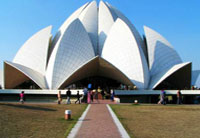| AHMEDABAD |
Ahmedabad drives its name from the 14th century ruler, King Ahmed Shah, who shifted the capital from Patan to Ahmedabad in 1411. Before then, around the 11th century, the area was known as Asaval and ruled by a Bhil Chief, followed by Solanki King Karnadev, under whom the city was renamed Karnavati. Historically, Ahmedabad was a major trading hub dealing with luxury goods and silk. The city pioneered the establishment of modern textiles and earned the nickname “Manchester of the East”. In addition to an intricate maze of neighborhoods called pols, the walled city of Ahmedabad has some of the country’s finest contributions of Sultanate period architecture, a style that depicts the Islamic-Jain-Hindu syntheses of that time.
|
|
 |
|
|
| PLACES OF ATTRACTION: |
BHADRA FORT: |
it is one name that indeed deserves a special mention. Constructed in 1411 during the rule of Marathas, it was established by Sultan Ahmed Shah. It’s a royal fort that occupies the most significant and attractive place to visit in Ahmedabad. Bhadra-Kali Temple was also built in this fort during reign of Aazam Khan. |
SIDDI SAYID MOSQUE AND JUMMA MASJID: |
Gurudwara Bangla Sahib is situated on the Gole Dakhana roundabout on Baba Kharak Singh Marg. The Gurudwara had a lake dug in the complex. The particular Gurudwara was built by Raja Jai Singh for Guru Harkrishan. The water of this lake is still attributed with medical powers. |
TEEN DARWAJA: |
it is an architectural marvel, the beauty of which is surely going to leave you awestruck. Consisting of gorgeous arched gates, Teen Darwaja is one of the longest as well as the oldest gateways of the city. |
SARKHEJ ROZA: |
about 8km from the city, Sarkhej Roza is a royal complex, which includes a mosque and several tombs dedicated to the memory of Ahmed Shah’s spiritual advisor. The compound id embellished with pierced stone trellises throughout and is best visited around sunset. |
STEP WALL of ADALAJ (ADALAJ NI VAV): |
built in 1499 by queen Rudabai this step wall at the village Adalaj is just 18kms from Ahmedabad. It is one of Gujarat’s best examples of step wall architecture and has excellent carvings of nature, animals, geometric motifs and more birds and fishes. Step wells were generally commissioned as resting places for travelers and caravans as stopovers along their trade routes. The wells also conserved water, offered respite from the heat and created a social space. |
SHAKING MINARETS: |
standing on the platform from where these pillars rise, you still feel like you are in an area just rocked by the earthquake. The shaking minarets of Bibi-ki-Masjid in Rajpur area of the city are almost falling apart with no move yet to resurrect this architectural wonder built in 1454. |
SWAMINARAYAN TEMPLE, Kalupur: |
it is historically the most important and religiously the most prominent because of the main deity, Shri Nar Narayan Dev, the first and the foremost in the world was ceremoniously installed by Shri Sahajanand Swami himself. |
KARNA MUKTESHWAR TEMPLE: |
founded by King Karna Dev Solanki, it is one of the oldest temples in Ahmedabad and is located outside Raipur Gate.
|
ISKCON TEMPLE: |
temple has much spacious interiors compared to its exterior portions. Huge halls decorated with beautiful chandeliers attribute the devoutness of the shrine. Prayer sessions in the temple provide a soothing feeling to the devotees as the entire ambience would be filled with the chanting of hymns and keertans.
|
HUTHEESING JAIN TEMPLE: |
built in 1850 from sandstone and pure white marble, the ornately carved Hutheesing Temple is a feats for the eyes, with every inch covered in mesmerizing relief work.
|
KANKARIA LAKE: |
this man-made lake dates from 1451, is a 34 sided polygon with a 1.25 kms circuit and steps leading down to the water level. In the center if the lake , on an artificial island, is the pleasure pavilion known as Naginavadi.
|
GANDHI ASHRAM: |
built in 1917, the Satyagraha Ashram was a focal point of India’s freedom movement. Situated on river Sabarmati, the Ashram has an extensive museum, library and various building like the Hridaya Kunj, the cottage of Gandhi ji.
|
SANSKAR KENDRA: |
it was designed by the eminent French architect Le Corbusier and is situated near Sardar Bridge. It includes the city museum, which highlights the Ahmedabad history, craft, architecture, religion and fine arts.
|
KITE MUSEUM: |
the museum houses a wonderful variety of kites that depicts their colourful history and regional flavors.
|
CALICO TEXTILE MUSEUM: |
established in 1949, it is regarded as one of the finest textile museum in the world. The museum displays a magnificent collection of the finest fabrics spun, woven, printed and painted in different parts of India. It also houses a collection of marble, sandstone and bronze icons, busts and an excellent reference library on textiles.
|
Other places to visit in Ahmedabad are: |
Rani Rupmati’s Mosque, Rani Sipri’s Mosque, Science City, Camp Hanuman, Lord Balaji Temple (SG Road), etc.
|